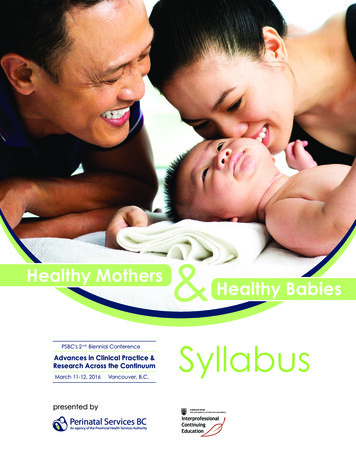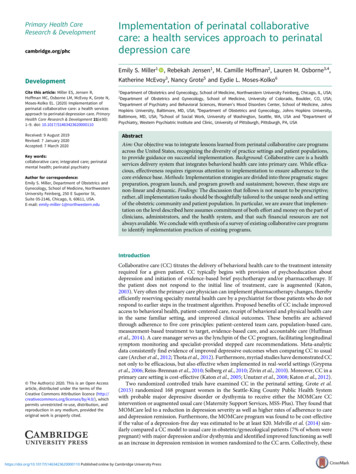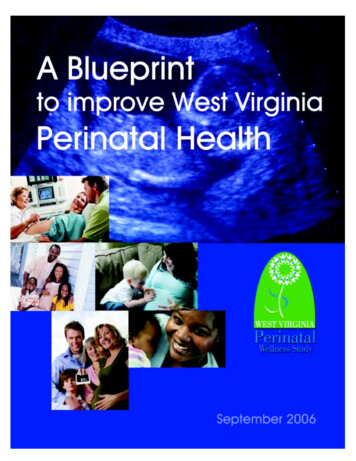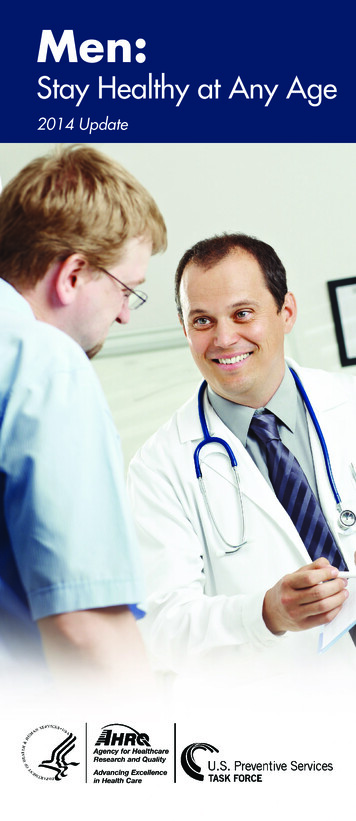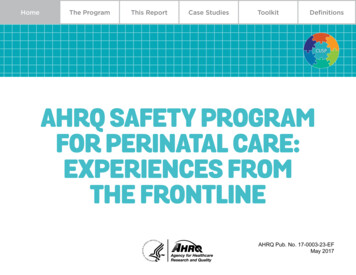
Transcription
HomeThe ProgramThis ReportCase StudiesToolkitDefinitionsAHRQ SAFETY PROGRAMFOR PERINATAL CARE:EXPERIENCES FROMTHE FRONTLINEAHRQ Pub. No. 17-0003-23-EFMay 2017
HomeThe ProgramThis ReportCase StudiesToolkitDefinitionsABOUT THE PROGRAMAHRQ Safety Program for Perinatal CareNeed for ChangeNine percent of all births in the United States involve serious obstetrical adverse events.At least 30 percent of these events are preventable.For more than a decade, poor teamwork and communication have remained the leadingcauses of maternal adverse events. Enhancing patient safety in the crucial hours surroundingbirth means reducing these preventable errors.Ways to reduce obstetrical adverse events include improving teamwork and communicationamong care teams, following standardized protocols, creating independent checks, learningfrom defects, effectively engaging patients and families, and practicing these skills throughin situ simulations.AHRQ Efforts To Improve Safety for Mothers and NewbornsThe goal of the AHRQ Safety Program for Perinatal Care is to decrease maternal and neonataladverse events and to improve patient safety, team communication, and quality of carewithin labor and delivery (L&D) units nationwide.AHRQ developed a comprehensive patient safety program that provides a platform and toolsto improve patient safety in L&D units. The toolkit provides guidance and resources forimplementing strategies to improve maternal and newborn safety within L&D units. The toolscan be customized to local unit processes and procedures.Several dozen L&D units across the country joined the Program. RTI International providedprogram materials and supported the units in implementing the toolkit through a series ofWeb-based trainings, ongoing technical assistance, and a comprehensive evaluation. Thisreport describes implementation experiences of several L&D units that successfullyimplemented the Program.Program Participants
HomeThe ProgramThis ReportCase StudiesToolkitDefinitionsTHIS REPORTAHRQ Safety Program for Perinatal CareThis report features five case studies that describe the implementation of the AHRQ SafetyProgram for Perinatal Care in labor and delivery (L&D) units at University of Arkansas forMedical Sciences, Onslow Memorial Hospital, Winnie Palmer Hospital for Women & Babies,Carle Foundation Hospital, and WakeMed Health & Hospitals System.Although all L&D units shared the same framework for safety improvements, each embarkedon a unique implementation path that was best suited to its local needs and resources. Thenational implementation team has captured these experiences through visits to theseorganizations and interviews with unit staff and leadership.An L&D team in the process of an in situ simulationSuggested Citation: AHRQ Safety Program for Perinatal Care: Experiences From theFrontline. Prepared under contract no. 2902010000241 (RTI International). AHRQ PublicationNo. 17-0003-23-EF. Rockville, MD: Agency for Healthcare Research and Quality. October 30,2016. www.ahrq.gov/perinatalsafety.This document is in the public domain and may be used and reprinted without permission.Under The Social Security Act (42 USC 1320b-10 (a)(2)(B)), reprinting or distribution of AHRQor other U.S. Department of Health and Human Services (HHS) materials for a fee is prohibitedwithout prior specific, written authorization.
HomeThe ProgramThis ReportCase StudiesToolkitDefinitionsCASE STUDIESAHRQ Safety Program for Perinatal CareClick to read each case study.University of Arkansas for Medical Sciences’ L&D unit had no prior experience with in situ simulations andlimited success with implementation of TeamSTEPPS before joining the Program. As result of participationin the Program, local facilitators have trained many nurses and new residents in TeamSTEPPS, implementedperinatal safety strategies for oxytocin administration and electronic fetal monitoring, and facilitated these newskills through in situ simulations. Academic medical center inLittle Rock, AR 483 total beds 14 L&D beds Level III neonatal intensive-care unit(NICU)Strategies:Safe oxytocin administration and safeelectronic fetal monitoringOnslow Memorial Hospital’s L&D unit had no formal training in TeamSTEPPS prior to joining the Programbut already used many teamwork and communication techniques and had a program of in situ simulations.During the course of the Program, the team implemented nearly all perinatal safety strategies and strength ened its teamwork and communication techniques and program of in situ simulations. Community hospital inJacksonville, NC 162 total beds 10 L&D beds Level III NICUStrategies:Electronic fetal monitoring, rapidresponse systems, safe oxytocinadministration, magnesium sulfate,obstetric hemorrhage, and shoulderdystociaWinnie Palmer Hospital for Women & Babies trained more than 85 percent of its nurses in TeamSTEPPS,implemented daily safety huddles, expanded its in situ simulations program, and made safety improvementspertaining to three clinical strategies. Observable improvements in teamwork and communication on the unithave led other hospital units to request initiatives to help them make similar safety improvements. Maternity hospital inOrlando, FL 320 total beds 27 L&D beds Level III NICUStrategies:Obstetric hemorrhage, electronicfetal monitoring, and obstetric rapidresponseCarle Foundation Hospital built on a prior statewide perinatal safety initiative by focusing on improvementspertaining to two clinical strategies and introduction of TeamSTEPPS. Unit staff reinforced the new processesthrough in situ simulations, which were already a standard practice. Due to the observable improvements inteamwork and communication on the unit, unit leaders are advocating for hospitalwide TeamSTEPPS training. Community-designated hospitalin Urbana, IL 322 total beds 12 L&D beds NICU Level IIIStrategies:Obstetric hemorrhage and safe oxytocinadministrationWakeMed Health & Hospitals System implemented the Program with the goal of ensuring standardizationacross all three system hospitals. Each hospital approached the Program in a way that met the local needs ofeach unit. Program participants incorporated some of the protocols into the system’s electronic health record. Private, not-for-profit health systemin Raleigh, NC Three hospitalsStrategies:Shoulder dystocia, electronic fetalmonitoring, obstetric hemorrhage,and safe use of magnesium sulfate
HomeThe ProgramThis ReportCase StudiesToolkitDefinitionsTOOLKIT COMPONENTSAHRQ Safety Program for Perinatal CareTeamwork andCommunicationLearn About the Comprehensive Unit-Based SafetyProgram (CUSP) for Perinatal Safety Slide Presentation & Facilitator NotesAssemble Team & Engage Leadership for Perinatal Safety Slide Presentation & Facilitator NotesImplement Teamwork & Communication for Perinatal Safety Slide Presentation & Facilitator NotesUnderstand the Science of Safety for Perinatal Safety Slide Presentation & Facilitator NotesSensemaking & Learn From Defects for Perinatal Safety Slide Presentation & Facilitator NotesEngage Patients & Families for Perinatal Safety Slide Presentation & Facilitator NotesSupporting CUSP Tools for Perinatal Safety Am I Ready To Become an Advisor Background Quality Improvement Team Information Form Be a Partner in Your Care Board Checklist CEO/Senior Leader Checklist Culture Checkup Tool Safety Issues Worksheet for Senior Executive Partnership Shadowing Another Professional Tool Staff Safety Assessment Team Checkup Tool Working With Patient & Family AdvisorsPerinatal SafetyStrategiesMonitoring for Perinatal SafetyElectronic Fetal Monitoring (EFM) Slide Presentation & Facilitator Notes Tool: Safe EFM Pocket CardSafe Medication Administration Slide Presentation & Facilitator Notes Tool: Safe Oxytocin Administration Tool: Safe Magnesium Sulfate AdministrationRapid Response for Perinatal SafetyObstetrical Rapid Response Slide Presentation & Facilitator Notes Tool: Rapid Response SystemsL&D Unit Safety Slide Presentation & Facilitator Notes Tool: Safe Cesarean Section Tool: Obstetric Hemorrhage Tool: Shoulder Dystocia Tool: Umbilical Cord ProlapseIn Situ SimulationGetting Started Slide Presentation & Facilitator Notes Tool: Facilitation Instructions for In Situ Simulation Tool: Training VideoSimulation Scenarios Postpartum Hemorrhage Shoulder Dystocia Umbilical Cord Prolapse Antepartum Hemorrhage Preeclampsia/Seizure Uterine Tachysystole Magnesium Toxicity Vaginal Birth After Cesarean (VBAC)/Abdominal Pain Postoperative Cesarean Section Complication
HomeThe ProgramThis ReportCase StudiesToolkitDefinitionsDEFINITIONSAHRQ Safety Program for Perinatal CareBrief: Short session prior to start of patient care to share the plan, discuss teamformation, assign roles and responsibilities, establish expectations and climate, andanticipate outcomes and likely contingencies.Callout: A strategy to communicate important or critical information that informs allteam members simultaneously during emergent situations.Check-back: Use of closed-loop communication to ensure that information conveyedby the sender is understood by the receiver as intended.Cross-monitoring: A harm error reduction strategy that involves monitoring actions ofother team members, providing a safety net within the team, ensuring that mistakes oroversights are caught quickly and easily, and “watching each other’s back.”CUS (I am Concerned! I am Uncomfortable! This is a Safety issue! “Stop the line.”):Reminds team members to make assertive statements.Debrief: Informal information exchange session designed to improve team performanceand effectiveness through lessons learned and reinforcement of positive behaviors.DESC Script: A constructive approach for managing and resolving conflict.Handoff: The transfer of information (along with authority and responsibility) duringtransitions of care across the continuum. It includes an opportunity to ask questions,clarify, and confirm.Huddle: Ad hoc meeting to re-establish situational awareness, reinforce plans already inplace, and assess the need to adjust the plan.In situ simulations: Trainings that allow health care teams to practice teamwork andcommunication and clinical management skills in a team’s usual work setting withtypically available resources and equipment.SBAR (Situation, Background, Assessment, Recommendation and Request): Atechnique for communicating critical information that requires immediate attention andaction concerning a patient’s condition.Shared mental model: Results from each team member maintaining situationawareness and ensures that all team members are “on the same page.”Situation awareness: The state of “knowing what’s going on around you.”Situation monitoring: The process of continually scanning and assessing a situation togain and maintain an understanding of what’s going on around you.TeamSTEPPS: An evidence-based framework for teamwork and communication thatoptimizes team performance across the health care delivery system.Two-challenge rule: Empowers all team members to “stop the line” if they sense ordiscover an essential safety breach.Adapted from TeamSTEPPS 2.0 Pocket Guide
UNIVERSITY OF ARKANSAS FORMEDICAL SCIENCESCase StudyTHE NEED TO CHANGEOver the last 10 years, deliveries in the labor and delivery(L&D) unit at the University of Arkansas for MedicalSciences (UAMS) Medical Center have increased from 2,100to 3,600 per year. To accommodate the increased demandfor services, the hospital has hired many new nurses,most of whom have been recent nursing school graduates.These new staff lacked knowledge and experience on bestpractices for electronic fetal monitoring (EFM) and oxytocinadministration. The implementation of the Agency forHealthcare Research and Quality (AHRQ) Safety Programfor Perinatal Care (SPCC) at UAMS targeted these twotopics because they complement each other, and becausestandardizing these practices among new nurses andresident physicians could improve patient safety.The UAMS Quality Improvement Department has beeninvolved in many internally and externally sponsoredpatient safety and quality improvement (QI) initiatives,including the Comprehensive Unit-based Safety Program(CUSP) for central line-associated bloodstream infectionsand a diabetes care initiative. However, the hospital had noprior experience with patient safety initiatives specific tothe women’s health service line or the L&D unit in particular.Joining the SPPC provided an opportunity to refocus theL&D unit around patient safety and offered a structuredway to review and change current practices.AHRQ Safety Programfor Perinatal CareComprehensive Unit-based SafetyProgram (CUSP)UNIVERSITY OF ARKANSAS FORMEDICAL SCIENCES MEDICALCENTER AT A GLANCE 438-bed academic medical centerin Little Rock, AR 14 labor and delivery beds Level III neonatal intensive-care unitTHE IMPLEMENTATION TEAMSelecting and implementing the two topics involved alarge multidisciplinary team, including the women’s healthservice line nursing director, a perinatal advanced practicenurse champion, staff nurses, the L&D nurse manager,QI coordinators, an obstetrician/gynecologist physicianchampion, an anesthesiologist physician champion,a resident physician, staff educators, a patient safetyofficer, and other ad hoc members such as a physicianinformaticist and pharmacists. Senior executives—including the medical director of obstetrics, the hospital’squality director, and the chief executive officer—supportedthe effort. They served as resources for any issues thatarose, provided approvals needed during implementation,and were kept informed of the implementation team’sprogress throughout the Program. The implementationteam saw the initiative as an opportunity to create aplatform for subsequent improvements in patient safetyand care.1
UNIVERSITY OF ARKANSAS FOR MEDICAL SCIENCES—Case StudyUNDERTAKING CHANGEStandardizing Oxytocin AdministrationOxytocin is listed as a high-risk medication by theInstitute for Safe Medication Practices and is used dailyon the L&D unit. Common errors when administering itare typically dose related and sometimes involve a lack oftimely recognition and appropriate treatment of excessiveuterine activity and/or maternal hypotension. In an effortto minimize the risk of errors and standardize oxytocinadministration during the intrapartum and postpartumperiods, the implementation team decided to institutethe practice of administering oxytocin via an intravenousinfusion pump.To this end, they took the following steps— Programmed intravenous infusion pumps hospitalwidefor standard oxytocin administration; Created a physician order set within the electronichealth record for oxytocin administration to establish astandard dosing protocol to reduce variability and risk oferror; and Prepared standard oxytocin admixture and dosing,resulting in a 1:1 ratio delivery that eliminated the needfor dosing calculation by nurses.The team also required all staff to view the CUSP“Understand the Science of Safety” video. This requirement“WE CREATED THESTRUCTURE WHERETHE RIGHT THING TODO WAS THE EASYTHING TO DO.”helped reinforce staff commitment to patient safety andgain support for the new processes and protocols. As oneUAMS physician noted, “We created the structure wherethe right thing to do was the easy thing to do, and thiswas very powerful.” In addition, the implementation teamplaced postpartum oxytocin administration referencecards in each L&D room. Together, these practices resultedin standardized, servicewide adoption for postpartumoxytocin administration.Enhancing Safe EFMTo continue efforts toward standardized practices, nurseeducators developed online educational modules to teachnurses the correct nomenclature for EFM documentationand communication with other L&D staff; these modulesare now required for all new nursing staff. In addition, unitleadership offered an increased number of fetal monitoringcourses based on a curriculum from the Association ofWomen’s Health, Obstetric, and Neonatal Nurses. Coursesare offered quarterly to new hires and existing staff.Training for anesthesia resident physicians now alsoincorporates standardized EFM nomenclature, and theUAMS College of Nursing has added EFM training totheir curriculum as well. As one nurse noted, “Having astandardized way we approach these two topics [oxytocinadministration and EFM] is a good way to orient newnurses and residents.”2
UNIVERSITY OF ARKANSAS FOR MEDICAL SCIENCES—Case StudyThrough these EFM trainings, all unit staff have learned thesame EFM nomenclature and are now able to more clearlycommunicate with and report to other staff members.L&D staff now use the same language to accuratelyinterpret and document EFM strips. Because of theimproved communication, staff members on the L&D unitnow feel that they are “on the same page.”Program Challenges and OpportunitiesThe biggest challenge to program implementation wasjuggling the schedules of resident physicians and findingtime to include them in the in situ simulation trainings. Asa physician leader noted, “We recognize the importance ofteaching our residents about patient safety, yet we strugglewith this because they already have so much on theirplates. We could use some discussion with others who arealso trying to figure this out.” In the future, the UAMS teamwill coordinate with the residency program to integratepatient safety and QI work into the residents’ schedules.The implementation team also acknowledged the difficultyof prioritizing QI and patient safety during a time whenthey experienced an increase in patient load and higherrisk patients. A physician leader noted, “We have to do abetter job of fitting this important quality improvementand patient safety work in when we are working at fullcapacity. We expanded our patient volume and are caring“WE EXPANDED OURPATIENT VOLUME AND ARECARING FOR MORE HIGHRISK PATIENTS THAN EVERBEFORE, SO IT IS EVENMORE CRUCIAL THAT WEDO THINGS RIGHT.”for more high-risk patients than ever before, so it is evenmore crucial that we do things right it’s a balancing act toget our work done and work to improve.”At the beginning of the Program, the implementation teamalso found it difficult to extract the data they needed toassess current processes related to the safe use of EFMand oxytocin administration, against which they couldmeasure the progress of the implementation. To rectifythe situation, they held several meetings with informationtechnology staff and incorporated check boxes into theirelectronic health record system for documentation ofEFM categories using standardized nomenclature andprocesses related to oxytocin administration during thethird stage of labor. This change also automated dataoutputs and reports.ENGAGING STAFF IN TEAMWORK ANDCOMMUNICATION TRAININGSAlthough L&D unit staff had prior experience with teamworkand communication programs, none of those efforts weresustained. TeamSTEPPS was implemented from 2009to 2013, but the Program ended due to a sharp increasein patient volume and staff workloads. Likewise, the unitstaff tried to implement a simulation program several yearsago, but the effort was abandoned because of logisticalchallenges and difficulties related to holding the trainingsat the simulation center and arranging the training for nightshift staff.The team resurrected past efforts and set an ambitiousgoal to train all unit staff in TeamSTEPPS. They offered acondensed 2-hour TeamSTEPPS refresher course for staffwho wanted to participate. In situ simulations focusedon teamwork and communication tools and techniques,specifically the SBAR technique, huddles, and debriefs.Simulations covered uterine tachysystole and includedoxytocin management and electronic fetal heart rateinterpretation, emergent cesarean section transfer to theoperating room, and a mock code to simulate a cardiac orpulmonary arrest situation in an obstetric patient.3
UNIVERSITY OF ARKANSAS FOR MEDICAL SCIENCES—Case StudyIn Situ Simulation: Providing a Safe LearningEnvironmentThe implementation team sought to make in situ simulationtrainings fun. The trainings were introduced gradually,first by way of miniature simulations and debriefings. Inthese, the L&D unit staff began a simulation and allowedit to continue for a short period of time, then stopped thesimulation and reviewed it with the staff. After a while, theteam was instructed to run through the whole simulation,and a debriefing session was held at the end. This “rampingup” approach to simulations helped to gain staff buy-in anddemonstrate the value of the simulations. It also reducedstaff anxiety about the simulations. To accommodate theschedules of L&D unit staff, simulations were scheduledduring shift changes to include staff who worked on dayand night shifts. The hospital’s simulation center providedassistance with preparation and debriefings.The implementation team used a unitwide newsletter tokeep staff informed and committed to in situ simulation.Eighty percent of the L&D nursing staff, as well asthe obstetrician/gynecologist physician champion andresident physicians, participated in simulations during theProgram. Participation was mandatory for nursing staff,and simulations were scheduled at times convenient forthe majority of staff. Simulation facilitators were mindfulnot to present the simulations as just another mandatorylow-level task. Instead, they set a collaborative and helpfultone: “We want to improve how we do things around here;we want to make it better. We’re starting out too [learninghow to facilitate these simulations], so help us help you.”This reduced resistance to participation, and staff sooncame to appreciate the safe learning environment.Over time and with repetition, the facilitators felt morecomfortable and more efficient in conducting simulations.As a nurse facilitator noted, “We now know how to plan andrun the simulations and value it as an effective teachingstrategy. It is a safe way to deal with high-risk situations.The simulations help tremendously with orienting new staffand provide an opportunity for them to ask questions.”“WE GAVE NURSESTHE AUTHORITY TO‘STOP THE LINE.’ THISWAS A VERY DIRECTWAY TO CHANGE OURCULTURE—AND HELPUS THINK MORE WITH ATEAM MENTALITY.”The BenefitsAs a result of the SPPC, the implementation team wasable to incorporate more resources to conduct in situsimulations than in earlier efforts and develop a moreorganized framework to ensure the success of therenewed teamwork training and simulation efforts.TeamSTEPPS training and simulations enhancedteamwork and created a sense of empowerment amongstaff, especially among the nurses. It also helped toimprove the staff’s confidence and cross-unit communi cation: for example, direct communication betweenobstetricians, anesthesiologists, and pediatricians is nowa standard practice in planning patient care. From theperspective of the implementation team, staff are nowmore comfortable reporting patient safety issues in theunit, and the decision-making process on the unit hasmoved from a hierarchical approach to a team-basedapproach: “By standardizing how we give oxytocin andby offering team-based approaches to communication,we empowered our nurses to prevent the induction oflabor in mothers who were near term. We gave nurses theauthority to ‘stop the line.’ This was a very direct way tochange our culture—and help us think more with a teammentality.”4
UNIVERSITY OF ARKANSAS FOR MEDICAL SCIENCES—Case StudyGOING FORWARDParticipation in the SPPC provided a wonderful opportunityto organize and methodically work to improve perinatalcare and safety. The changes made to oxytocinadministration and EFM are now hard-wired into L&D unitpolicies and procedures; according to unit staff, the policiesare now internalized as “how we do things around here.”The UAMS team continues to conduct in situ simulationsquarterly.To formalize their commitment to ongoing quality andsafety improvements, the UAMS implementation teamre-branded themselves as the Women’s Health ServiceLine Safety Committee. UAMS leadership approved newpriorities for the women’s health service line as part of astrategic 5-year quality and safety plan, ensuring supportand resources for further improvements.Because of the visible improvements prompted bythe implementation of initiatives covering the initialtwo topics, the committee has decided to cover anew topic, obstetric hemorrhage, as the next areafor improvement. The committee also plans toinstitute annual TeamSTEPPS training for new staffand for existing staff who have not yet participatedin training.KEY STRATEGIES FOR SUCCESSSupport from Medical Center’s QI Department. The hospital QI helped navigate the changeprocess, organize and guide the team, distribute materials, schedule and facilitate meetings,keep the team on target, and track progress.Leadership commitment and support. The hospital and departmental leadership helpedassure the Program team of ongoing support and guidance through open communication andengagement in the trainings and other program activities.A multidisciplinary implementation team. This team included members with a wide rangeof expertise and knowledge. Involvement from physicians and pharmacy staff was critical ingetting new order sets written for oxytocin and new policies and procedures for dispensingoxytocin to the unit.Engagement strategies. The staff facilitating in situ simulations and providing staffeducation made the process fun and engaged staff through ongoing discussions about thisprogram and by providing updates in a unitwide newsletter.5
ONSLOW MEMORIAL HOSPITALCase StudyIMPLEMENTATION ENVIRONMENT:WE WANT TO BE THE SAFEST PLACETO HAVE A BABYOnslow Memorial Hospital (OMH) is located in Jacksonville,North Carolina, a midsized city with a population of about70,000 near U.S. Marine Corps Base Camp Lejeune andNew River Air Station. OMH is the only civilian hospital inthe county.As is typical of organizations in transient military com munities, OMH has a high rate of staff turnover. Hospitalmanagement noticed that this lack of consistency led to alack of communication, which in turn led to safety issues.Hospital management knew they needed to make achange. As a hospital leader noted, “If we don’t fix theproblems we’re not going to get out of the situation. It’sjust going to cycle back around again.”In order to “be the safest place for women to have theirbabies in the community,” the OMH administration under took several quality improvement activities. The hospitaljoined the North Carolina/Virginia Hospital EngagementNetwork (NoCVA) and the Perinatal Quality Collaborativeof North Carolina, and later the Agency for HealthcareResearch and Quality (AHRQ) Safety Program for PerinatalCare (SPPC), to sustain the changes and initiate newimprovements. In the words of the local SPPC facilitator,“my goal was to engage staff and to hardwire some ofthese best practices.”AHRQ Safety Programfor Perinatal CareComprehensive Unit-based SafetyProgram (CUSP)ONSLOW MEMORIAL HOSPITALAT A GLANCE 162-bed community hospital inJacksonville, NC 10 labor and delivery beds Level III neonatal intensive-care unitIMPLEMENTATION TEAMThe core implementation team included the assistant nursemanager for labor and delivery (L&D) and postpartum, thedirector for maternal and child services, the senior vicepresident of nursing/chief nursing officer, a physicianchampion, two staff nurses, and the assistant manager fornursery and pediatrics. The L&D nurse manager facilitatedprogram activities, and the director for maternal and childservices and the physician champion provided support.Despite high staff turnover on the L&D unit, the OMHleadership team has had a long tenure, and this stabilityled to an organizational commitment to a culture of safety.OMH leaders recognized that in order to overcome thechallenges that arise from the frequent staff changes,they would need to hardwire teamwork and efficientcommunication into the hospital’s culture.1
ONSLOW MEMORIAL HOSPITAL—Case StudyDecisionmaking at this hospital is based on what is thebest for the patients. An OMH senior leader noted, “What Ishare with my [unit] leaders is that, just on a day-to-daybasis, as long as you’re making the decision that’s in thebest interest for the patient, you’ll always have 100 percentof my support.” As confirmation of this commitment, thesenior leadership provided guidance and support to theimplementation team and held them accountable forprogram implementation. Hospital leadership receivedregular updates during bimonthly obstetrics and gynecology committee meetings where the local facilitatorprovided updates on program activities and debriefed onnear-misses or adverse events.The implementation team was bolstered by a highlyengaged physician champion who is well-respected at thehospital and in the community and who chairs the hospitalmedical staff committee. The physician champion’s statureand authority facilitated the engagement and buy-in ofother physicians, especially during the introduction of newprotocols and procedures.The implementation team found that many of the SPPCfocus topics would benefit their unit. However, they alsoknew that they could not tackle multiple topics at once, sothey selected those that were most feasible to implementon their unit: safe administration of magnesium sulfate,and safe practices and teamwork related to care providedduring deliveries complicated by shoulder dystocia.STANDARDIZING MAGNESIUM SULFATEADMINISTRATIONIn order to decrease the chance of possible harm duringlabor, it was important to standardize protocols forthe administration of magnesium sulfate. A unit nurseexplained, “It’s a dangerous drug that we need to berespectful of, so having a plan and knowing it is alwaysbetter than going on the fly.” As a first step, the localfacilitator and physician champion met to review the“WHAT I SHARE WITH MY[UNIT] LE
most of whom have been recent nursing school graduates. These new staff lacked knowledge and experience on best practices for electronic fetal monitoring (EFM) and oxytocin administration. The implementation of the Agency for Healthcare Research and Quality (AHRQ) Safety Program for Perinatal Care (SPCC) at UAMS targeted these two

